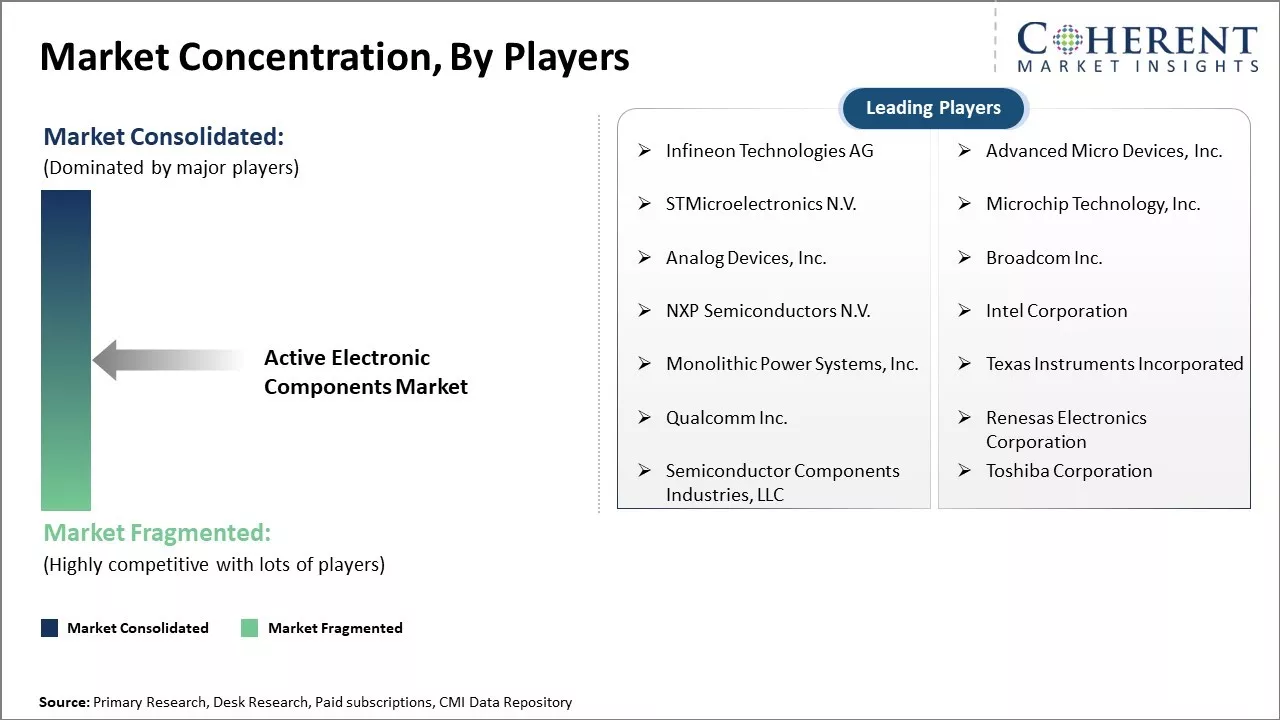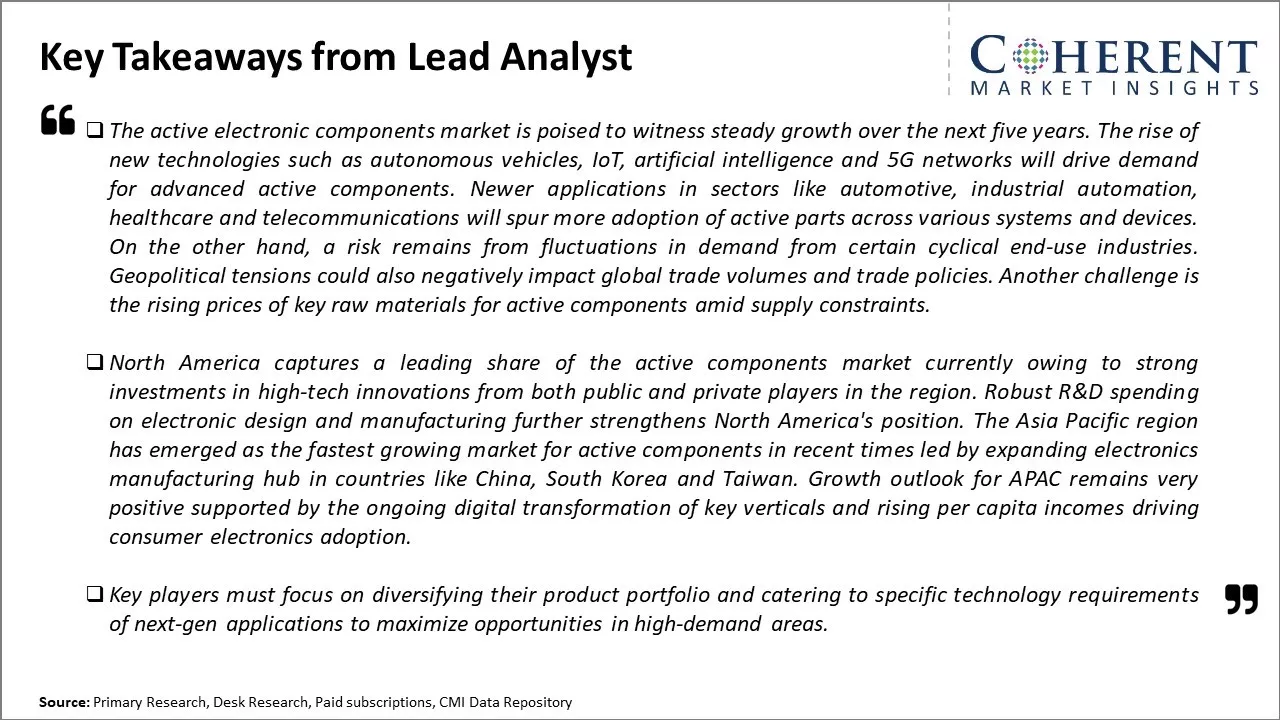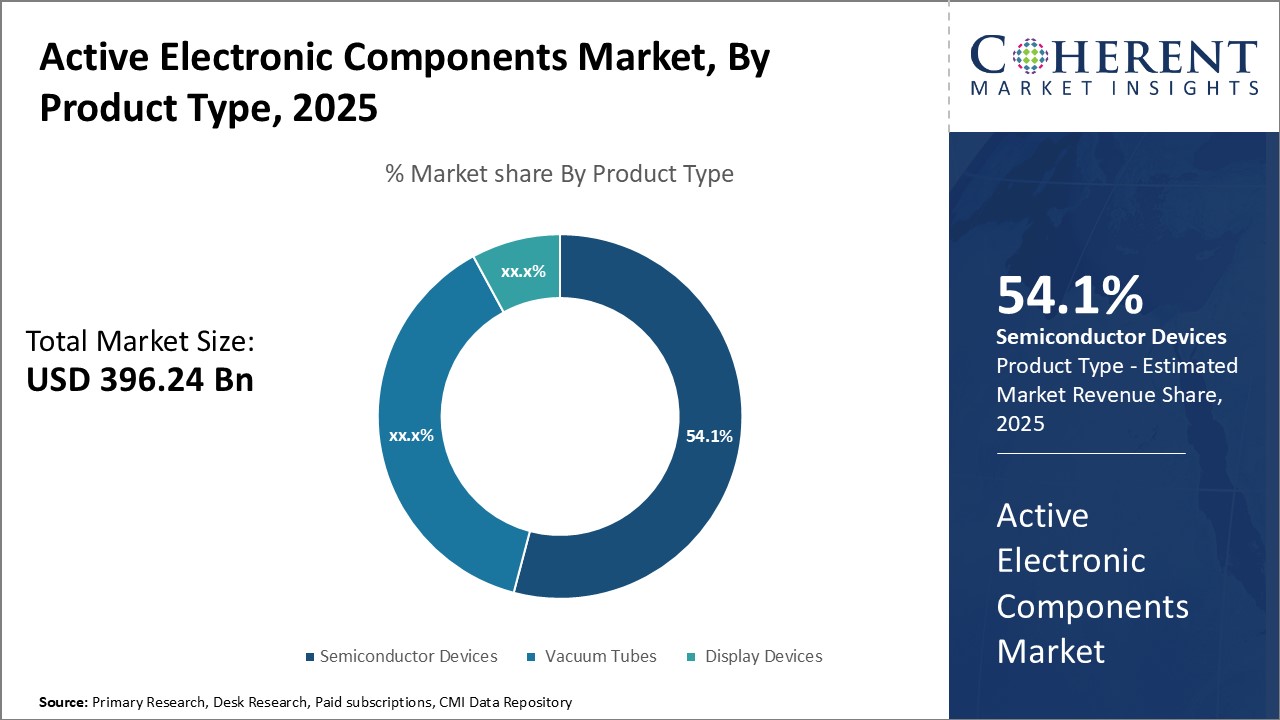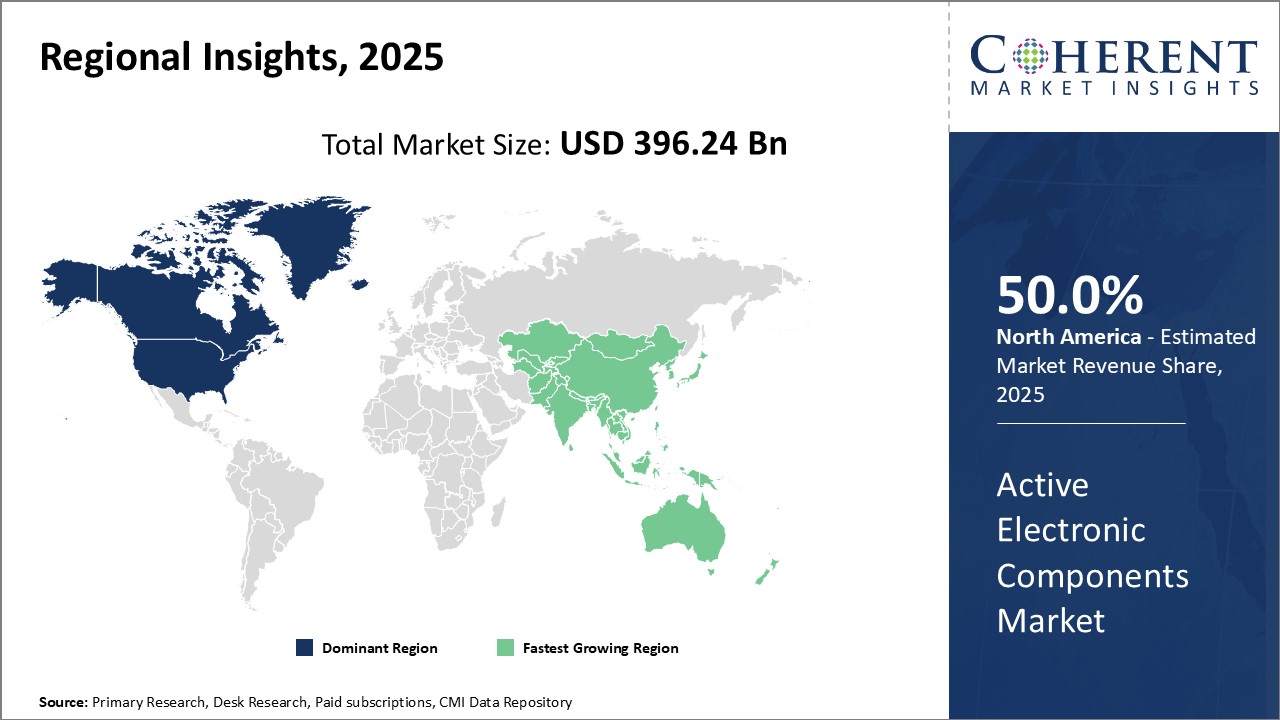The Active Electronic Components Market is estimated to be valued at US$ 396.24 Bn in 2025 and is expected to reach US$ 729.48 Bn by 2032, exhibiting a compound annual growth rate (CAGR) of 9.1% from 2025 to 2032.

Discover market dynamics shaping the industry: Request sample copy
The market is expected to witness positive growth over the forecast period. Smart technologies and IoT applications are expected to drive the demand for active electronic components. Emerging sectors such as electric vehicles and renewable energy are further expected to open new avenues for the market growth. Semiconductor shortages experienced during the pandemic temporarily disrupted the supply chain, however investments in capacity expansions are expected to smoothen supply over the coming years. Rising demand from applications in data centers, consumer electronics and automotive coupled with government support for semiconductor manufacturing are expected to provide opportunities for sustainable market expansion.

Get actionable strategies to beat competition: Request sample copy
Growing Demand for Smart ElectronicsThe demand for advanced smart electronic devices has been rapidly increasing over the past few years. With the growing capabilities of semiconductors and electronic components, manufacturers have been able to develop a wide variety of smart devices with novel features and functionalities. Smartphones have become vastly more intelligent compared to early cellular phones, featuring powerful processors, advanced displays, high resolution cameras, and a whole host of sensors. Consumer electronics such as smart TVs, wearables, and smart home appliances now have extensive connectivity and automated functionalities. Advanced driver assistance systems and infotainment consoles in automobiles incorporate a multitude of electronic control modules and complex embedded systems.
This rising complexity and intelligence of modern electronics has greatly boosted the demand for sophisticated active electronic components. Sophisticated power management ICs, microprocessors, memory and storage devices, and cutting-edge wireless communication chips are some of the key components that have enabled the new capabilities in smartphones, laptops, vehicles, and other smart systems. As these devices progress towards narrower form factors with even higher performance levels, greater levels of component integration are required. Manufacturers are under constant pressure to develop application-specific integrated circuits, system-on-chips, and hybrid modules with improved functional integration. This need for finely optimized active components tailored to specific system-level requirements is a major driver propelling the market growth. With the continued digitization and network connectivity of more product categories, the momentum behind complex smart systems looks set to ensure sustained demand growth for advanced electronic components in the coming years.
Pressure to Reduce System Power Consumption
With the proliferation of battery-powered mobile devices and energy efficiency becoming a critical design priority, there is growing pressure on component manufacturers to deliver semiconductors and modules with ultra-low power characteristics. The demand for longer battery life in smartphones, tablets, and wearable devices before needing recharge has prompted chip developers to focus on power optimization techniques. Manufacturers are engineering active components like processors, wireless transceivers, and display driver ICs with capabilities such as dynamic voltage and frequency scaling, specialized low-power modes, and finely granular power management protocols. At the same time, passive components are advancing with traits such as ultra-low equivalent series resistance to minimize power losses.
As internet of things (IoT) and edge computing expand into a wider array of applications with embedded systems, energy efficiency is a major commercialization factor.

To learn more about this report, Request sample copy
Market Challenges: Competitive Pressures in the Active Electronic Components MarketThe active electronic components market faces challenges from an influx of cheaper generic products from Asian manufacturers. Major brands must constantly innovate to maintain an advantage over these lower-cost competitors. The rapid changes in consumer technology also require staying ahead of the latest trends to design components for emerging devices.
Market Opportunity: Expanding Demand in the Active Electronic Components Market
On the other hand, the growing "Internet of Things" provides a major opportunity for the active electronic components market. As more everyday objects become smart and connected, they need advanced internal components like sensors, processors, and wireless chips. This rapid expansion into new product categories means active component producers can tap into expanding demand from many industries adopting IoT technologies.

Discover high revenue pocket segments and roadmap to it: Request sample copy
Insights, By Product Type - Semiconductor Devices Powering Innovation in ElectronicsSemiconductor devices contribute the largest share of 54.1% of the active electronic components market due to their widespread and diverse applications across industries. Semiconductors form the core technology that has enabled innovations from computers to smartphones to advanced manufacturing equipment. As electronics become increasingly integrated into everyday products and industrial processes, the demand for semiconductor devices continues to grow steadily.
A key driver of the semiconductor devices segment is the constant push for faster, smaller, and more powerful chips. Manufacturers are relentlessly working to pack more transistors onto integrated circuits following Moore's Law, allowing for new generations of more capable processors, memory, and logic chips. Miniaturization has fostered rapid growth in portable electronics like smartphones and tablets, with each new model demanding slimmer, lighter, and more power-efficient semiconductors. Meanwhile, industries like automotive and healthcare rely on increasingly sophisticated and customizable semiconductors for advanced functions like driver-assistance systems, medical imaging, and patient monitoring equipment.
Another factor fueling the semiconductor devices segment is the rise of new technologies that utilize customized chips. The emerging Internet of Things will connect billions of smart sensors and devices, all of which will require dedicated silicon. Artificial intelligence, virtual and augmented reality, and blockchain all depend on specialized semiconductors designed for their unique data and computing demands. Across industries, businesses are discovering new ways to digitally transform their operations through customized integrated circuits. The need for application-specific chips will only grow as technologies mature.
Overall, the flexibility and widespread applicability of semiconductor devices make them indispensable components for both consumer goods and industrial systems. Continued innovation in chip design and fabrication will drive further adoption across end markets, ensuring ongoing strong growth of the semiconductor devices segment within the active electronic components industry.
Insights, By End user- Consumer Electronics: A Mainstream Adoption Driver
The consumer electronics end-user segment generates the largest share of 29.6% in 2025 of demand in the active electronic components market. As personal technology becomes more integrated into daily life, consumer needs propel technological advances that benefit the overall industry.
A primary driver is the growing number of smart, connected devices owned by individuals worldwide. New product launches in areas like smartphones, tablets, smartwatches, and smart home devices uphold continuous demand for the latest electronic components. Even as upgrade rates decelerate from their peak, the installed base of these intelligent consumer products depends on annual replenishment of active components.
Additionally, new usage models emerge that further drive component sales. Streaming multimedia on various screens inside and outside the home requires higher performance components to deliver seamless high-definition experiences. Connected devices also depend on always-on networking capabilities enabled by advanced radios and wireless chips. As artificial intelligence assistance becomes embedded in consumer electronics, specialized machine learning chips will gain prominence.
Perhaps most significantly, sustained mainstream penetration of new technologies validates their industrial viability. From early adoption phases, successful consumer technologies like PCs, web-connected devices, and mobile phones have grown to become fundamental tools across society. Their widespread consumer acceptance stimulates active component manufacturers to innovate at an accelerated pace to meet mass-market needs. In turn, business and industrial sectors increasingly rely on technologies proven through the scrutiny of the consumer market.
In summary, the influence of the vast consumer electronics segment spreads far beyond its direct share. By popularizing emerging technologies, consumers drive greater active component innovation to benefit all end users. Their continued appetite for the latest intelligent devices guarantees ongoing leadership of this end-user segment within the industry.

Need a Different Region or Segment? Customize now
North America has established itself as the dominant region with 50.0%in 2025 of the active electronic components market over the years. With major presence of industry leaders such as Texas Instruments, Intel, and Qualcomm, the region accounts for the largest share of global revenues. The strong industrial base and robust manufacturing infrastructure enables component manufacturers to maintain efficient supply chains and undertake large-scale productions. This allows them to offer highly competitive pricing for the components, which has helped expand market adoption across various application sectors including automotive, IT, telecom, and industrial.
In addition, the presence of strong in-house R&D capabilities has helped component companies in the region develop cutting-edge technologies. This has ensured that they lead in innovation and can rapidly commercialize new solutions to capture early demand. As a result, North American companies have gained technological superiority and established themselves as technology leaders in several key product categories such as integrated circuits, semiconductors, and microchips. They also export significant volumes of advanced components globally, strengthening their foothold.
The Asia Pacific region has emerged as the fastest growing market for active electronic components. Countries like China, Japan, South Korea, and India have accelerated their investments in electronics manufacturing industries over the recent years. China in particular has come up as a major production and export hub, contributing immensely to the market's expansion here. This can be attributed to factors like availability of low-cost skilled workforce, increasing indigenous component manufacturing capabilities, supportive government policies and initiatives to establish semiconductor clusters.
Besides, the exponentially rising electronics demand from the consumer sector driven by increasing disposable incomes in developing Asian nations, has benefitted the components industry. Automotive production is also witnessing an exponential growth due to rising domestic vehicle sales across major economies. All of these factors have fueled the need for active components within the region and established Asia Pacific as the global future growth engine for this market.
Active Electronic Components Market Report Coverage
| Report Coverage | Details | ||
|---|---|---|---|
| Base Year: | 2024 | Market Size in 2025: | USD 396.24 Bn |
| Historical Data for: | 2020 To 2024 | Forecast Period: | 2025 To 2032 |
| Forecast Period 2025 to 2032 CAGR: | 9.1% | 2032 Value Projection: | USD 729.48 Bn |
| Geographies covered: |
|
||
| Segments covered: |
|
||
| Companies covered: |
Infineon Technologies AG, Advanced Micro Devices, Inc., STMicroelectronics N.V., Microchip Technology, Inc., Analog Devices, Inc., Broadcom Inc., NXP Semiconductors N.V., Intel Corporation, Monolithic Power Systems, Inc., Texas Instruments Incorporated, Qualcomm Inc., Renesas Electronics Corporation, Semiconductor Components Industries, LLC, and Toshiba Corporation |
||
| Growth Drivers: |
|
||
| Restraints & Challenges: |
|
||
Uncover macros and micros vetted on 75+ parameters: Get instant access to report
*Definition: The Active Electronic Components Market consists of semiconductors and integrated circuits that are essential components of virtually all electronic equipment. Active components supply energy and signals for processing and control in devices like computers, smartphones, networking equipment, automobiles, industrial equipment, medical devices and more. This growing market includes transistors, thyristors, integrated circuits, microchips, sensors and other components that are at the heart of today's burgeoning digital economy and are key enablers for technologies like AI, IoT, and 5G.
Share
Share
About Author
As an accomplished Senior Consultant with 7+ years of experience, Pooja Tayade has a proven track record in devising and implementing data and strategy consulting across various industries. She specializes in market research, competitive analysis, primary insights, and market estimation. She excels in strategic advisory, delivering data-driven insights to help clients navigate market complexities, optimize entry strategies, and achieve sustainable growth.
Missing comfort of reading report in your local language? Find your preferred language :
Transform your Strategy with Exclusive Trending Reports :
Frequently Asked Questions
Joining thousands of companies around the world committed to making the Excellent Business Solutions.
View All Our Clients
US Reciprocal Tax Impact Analysis On Active Electronic Components Market
Stay updated on tariff changes with expert insights and timely information